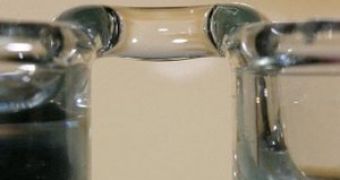Even if water is one of the most important and abundant molecules on Earth, it has unique traits, determined by hydrogen bonds, that still puzzle scientists. A recent research found a new one.
"The interaction of water with electric fields has been intensely explored over the last years. We report another unusual effect of liquid water exposed to a dc electric field: the floating water bridge." said Elmar Fuch from the Graz University of Technology in Austria.
When his team put water in two beakers to a high-voltage electric field, the liquid climbed out of the beakers and filled the empty space between, joining and forming a water bridge and the hovering water seemed to defy gravity.
The investigation revealed the water was moving from one beaker to another (from the anode beaker to the cathode one) and the cylindrical hovering bridge, with a width of 1-3 mm, could stand when the beakers were furthered up to 25 mm.
The odd phenomenon is determined by the structure of the water. The bridge is initiated by the electrostatic charges on the water's surface. The electric field then starts to form inside the water a highly ordered and stable microstructure that keeps the bridge intact.
The microstructure hypothesis came after the team detected that the water's density varies between the beaker edges and its center, pointing to a microstructure made of the arrangement of water molecules.
High-speed camera and visualization systems found high frequency oscillations inside the bridge, matching inner structures, not induced by surface tension, but by the waviness of the voltage charge.
At the beginning of the experiment, a sole inner structure was formed, but after a few minutes supplementary structures were added, provoked by either dust contamination or the increasingly higher temperature of the liquid bridge, induced by electricity. In just 45 minutes, water warmed from 20 ?C to over 60 ?C, causing the collapse of the bridge.
By now, researchers are investigating microstructures' degree of order shedding light on the density shifts observed in the water bridge.

 14 DAY TRIAL //
14 DAY TRIAL //